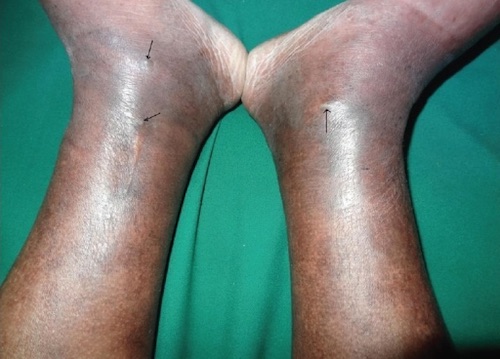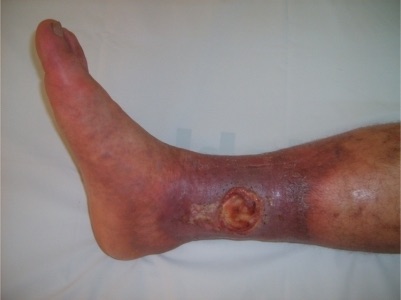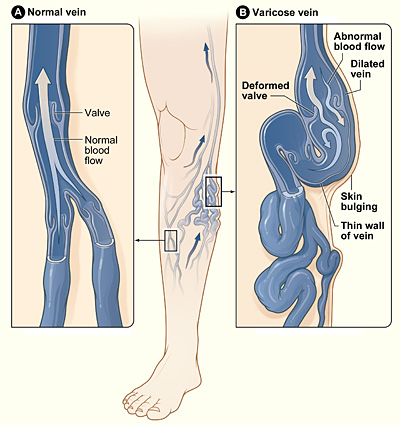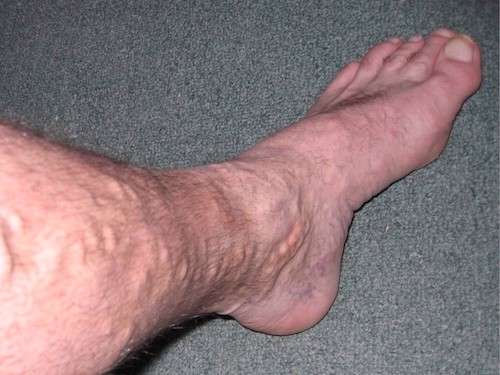Vascular: Chronic Venous Insufficiency & Varicose Veins
Chronic Venous Insufficiency (CVI)
Basics
- Definition: Malfunctioning Veins Failing to Return Blood Back to the Heart
- Results from Venous Hypertension
- Causes:
- Valve Incompetence
- Obstruction (DVT, etc.)
- Typically Referring to the Lower Extremities
Presentation
- Discomfort/Heaviness
- Pain
- Swelling
- Skin Discoloration
- Pruritis
- Numbness & Paresthesias
- “Brawny Edema”
- Brown-Blue-Grey Hyperpigmentation from Hemosiderin Deposition
- Venous Ulcers
- Most Common Site: Superior/Posterior to Medial Malleolus

Brawny Edema 1

Venous Stasis Ulcer 2
CEAP Classification
| Clinical (C) | Etiology (E) | Anatomy (A) | Pathophysiology (P) |
| 0 – None
1 – Small Varicose Veins (Telangiectasia or Reticular Veins) 2 – Large Varicose Veins 3 – Edema 4 – Skin Changes 5 – Healed Ulceration 6 – Ulceration |
C – Congenital
P – Primary S – Secondary |
S – Superficial
D – Deep P – Perforators |
R – Reflux
O – Obstruction |
Diagnosis
- Often a Clinical Diagnosis
- Duplex US – Preferred Test
Treatment Approach
- Initial Treatment: Conservative Management
- If Refractory: Surgical Treatment
- First Step: Treat Superficial Venous Reflux
- Second Step: Treat Perforator Venous Reflux
- Last Step: Treat Deep Venous Reflux
Conservative Management
- Lifestyle Modifications (Exercise, Ambulate, Weight Loss & Smoking Cessation)
- Leg Elevation
- Gradient Compression Stockings
- Classes of Pressure:
- Class 1: 10-15 mmHg
- Class 2: 20-30 mmHg
- Class 3: 30-40 mmHg
- Class 3-High Compression: 40-50 mmHg
- Use:
- C1-2 Disease – Use Class 1-2 Stockings
- C3 Disease – Use Class 2-3 Stockings
- C4-6 Disease – Use Class 3 Stockings (Mainstay of Treatment)
- Classes of Pressure:
- Unna Boot
- Multilayer Compression Device
- Inner Layer: Gauze Soaked with Zinc Oxide, Calamine, Glycerin, Sorbitol & Magnesium Aluminum Oxide
- Outer Layer: Elastic Wrap Providing Compression
- Provides 50-60 mmHg Pressure
- Dressing Changed Weekly
- Used for Venous Ulcers (91% Healing Success)
- Multilayer Compression Device

Unna Boot
Surgical Treatment
- Superficial/Perforator Treatment:
- Radiofrequency Ablation (RFA)
- Generally Preferred for Superficial Venous Reflux
- Start Proximal & Then Move Distal
- Contraindications: Proximal Tortuous GSV or Dilated > 15 mm
- Endovenous Laser Ablation
- Sclerotherapy
- Generally Preferred for Perforator Venous Reflux
- Vein Stripping/Ligation
- Radiofrequency Ablation (RFA)
- Deep Treatment:
- Valve Reconstruction
- Contraindications: DVT or Severe Peripheral Arterial Disease
Endovenous Heat-Induced Thrombus (EHIT)
- Thrombotic Complication of GSV/SSV Ablation Procedures
- Prevent by Keeping Ablation ≥ 2.5 cm Away from the Deep Vein Junction
- Generally Resolves Faster than Typical DVT’s
- Classification:
- Class I: Thrombus Stops at the Saphenofemoral or Saphenopopliteal Junction
- Class II: < 50% Occlusion of the Deep Vein (Most Common)
- Class III: > 50% Occlusion of the Deep Vein
- Class IV: Occlusive DVT
- Treatment:
- Class I: None
- Class II: Weekly Surveillance Until Resolution
- Class III: Anticoagulation Until Resolved
- Class IV: General DVT Management
Varicose Veins
Basics
- Definitions:
- Varicose Veins: Dilated (≥ 3 mm) Subcutaneous Veins of the Lower Extremities in the Upright Position
- Reticular Veins: Dilated (1-3 mm) Thin-Walled Superficial Venules
- Telangiectasias (Spider Veins): Dilated (0.1-1.0 mm) Superficial Venules, Capillaries & Arterioles
- Serpentine Branches of:
- Great Saphenous Vein
- Small Saphenous Vein
- Collateral Veins
- Often Associated with Superficial Venous Insufficiency
Risk Factors
- Smoking
- Elderly
- Obese
- Pregnancy
- Low Activity
- DVT
Symptoms
- Most Patients are Symptomatic
- Aching/Pain
- Burning
- Swelling
- Heaviness
- Bleeding
- Ulceration
Treatment
- Evaluate for Venous Insufficiency Prior to Treatment
- If Superficial Venous Insufficiency Found Consider Concurrent Treatment vs Delayed Treatment of Varicose Veins After Treatment of Insufficiency (Debated)
- Never Treat Varicose Veins Before Superficial Insufficiency – Will Recur
- Conservative Management: Compression & Elevation
- Can Promote Symptomatic Relief
- Will Not Resolve Underlying Pathology
- Definitive Treatment Options:
- Sclerotherapy – Often Preferred
- Endovenous Laser Ablation (EVLA)
- Stab Phlebectomy
- High Ligation
- Axial Stripping

Varicose Veins 3

Varicose Veins 4
References
- Chatterjee SS. Venous ulcers of the lower limb: Where do we stand? Indian J Plast Surg. 2012 May;45(2):266-74. (License: CC BY-NC-SA-3.0)
- Seyahi E, Yurdakul S. Behçet’s Syndrome and Thrombosis. Mediterr J Hematol Infect Dis. 2011;3(1):e2011026. (License: CC BY-2.0)
- National Heart Lung and Blood Institute. Wikimedia Commons. (License: Public Domain)
- Wikimedia Commons. (License: Public Domain)